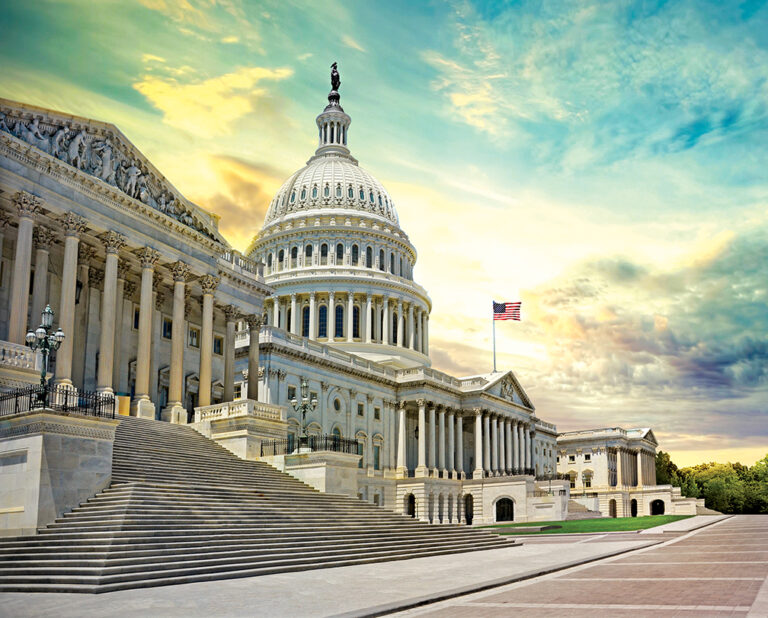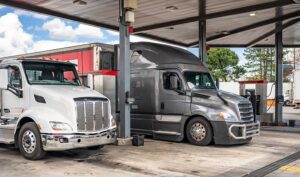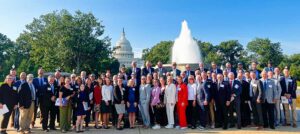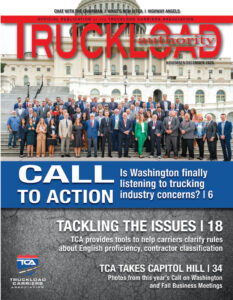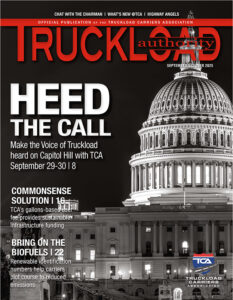This Capitol Recap describes the efforts throughout Washington to foster change. The National Highway Traffic Safety Administration wants Americans to speed less. The Department of Transportation wants to make it easier to get money to build and repair big bridges. The Governors Highway Safety Association wants to change a culture of distracted drivers. The federal government wants to utilize a newly developed framework to help drivers cut back on greenhouse gases. Transportation Secretary Pete Buttigieg wants to improve racial equity across our infrastructure, and a House committee wants to increase the number of truck parking spaces in the U.S. Details about these initiatives and more follow.
Biden’s Trucking Action Plan progresses
The Federal Motor Carrier Safety Administration (FMCSA) has announced that the Biden administration is following through on its Trucking Action Plan by awarding more than $44 million in grants that will enhance road safety and make the process to obtain a commercial driver’s license (CDL) more efficient.
The administration, in a news release, stated that “states and other entities will be able to improve their CDL programs by reducing wait times, ensuring conviction and disqualification data is electronically exchanged, implementing regulatory requirements, and combatting human trafficking. These grants, awarded through the Commercial Driver’s License Program Implementation (CDLPI), will help get more qualified drivers on the road who can help meet supply chain demands.”

U.S. Transportation Secretary Pete Buttigieg said the administration has made the trucking industry a top priority.
The Biden administration’s plan is designed to retain truck drivers and improve recruitment.
“Now, using funds from the Bipartisan Infrastructure Law, we are helping states bring safe, well-trained truck drivers into the workforce and ease pandemic-driven supply chain disruptions,” Buttigieg said.
The infrastructure law included a 74% increase in CDLPI program funds which, the administration says, will also help address the rising number of roadway fatalities,
“FMCSA’s core mission is safety, and we’re proud to make investments that support the U.S. Department of Transportation’s ambitious goal of zero fatalities on our roadways,” said FMCSA Deputy Administrator Robin Hutcheson. “The grants we are announcing today are an important tool for reducing large truck crashes and supporting critical safety programs in every state.”
In total, nearly 60% of FMCSA’s annual budget provides states and local communities with grant funding to enhance commercial vehicle safety.
“In addition to improving the process for CDLs, Secretary Buttigieg and President Biden’s Supply Chain Disruption Task Force have also been focused on the issue of truck driver retention as part of the Trucking Action Plan,” the news release stated.
“Due to pay, parking shortages, and other challenges in the profession, retaining truck drivers has been a major challenge. As part of that effort, the Department has announced that it will undertake a driver compensation study and form a truck leasing task force, and also has clarified what programs in President Biden’s Bipartisan Infrastructure Law can be used to address truck parking.”
Applications open for bridge investment plan

The Federal Highway Administration (FHWA) has opened a call for applications for the competitive Bridge Investment Program, highlighting what it calls President Joe Biden’s commitment to the nation’s infrastructure. The program was established by the president’s Bipartisan Infrastructure Law, which includes the single largest dedicated investment in bridges since the construction of the Interstate Highway System.
The program will provide $12.5 billion over five years. Nearly $2.4 billion is available during Fiscal Year 2022 to help plan, replace, rehabilitate, protect, and preserve some of the nation’s largest bridges. This competitive grant program comes on top of more than $27 billion in formula bridge funding that the U.S. Department of Transportation (USDOT) announced earlier this year. This investment will help ensure some of the nation’s most important bridges remain operational; in turn, it will bolster local economies, strengthen supply chains, improve safety, and create good-paying jobs.
“With resources from President Biden’s Bipartisan Infrastructure Law, we’re thrilled to begin accepting applications for one of the most significant investments in our bridges in decades, fixing everything from America’s most economically significant bridges to smaller bridges that mean everything to a local community,” said Transportation Secretary Pete Buttigieg.
“When these bridges are repaired, the American people will benefit from greater safety, lower shipping costs for consumers and maintenance costs for drivers, faster movement of goods across our supply chains, fuel savings, and precious time being returned to their day,” he said.
The Bridge Investment Program is a competitive, discretionary program that focuses on the repair, rehabilitation, or replacement of existing bridges across the country to reduce the overall number of bridges that are rated either as “poor condition” or “fair condition at risk of declining into poor condition.” It also expands applicant eligibilities to create opportunity for all levels of government to be direct recipients of program funds. In addition to states and federal lands management agencies, metropolitan planning organizations and local and tribal governments can also apply directly to the FHWA, making it easier to advance bridge projects at the local level.
The Bridge Investment Program provides an additional $12.5 billion in funding to the more than $27 billion provided to states by the Bridge Formula Program that was announced earlier this year. Combined, this $40 billion investment provided by President Biden’s Bipartisan Infrastructure Law gives the Department the ability to fund numerous bridge improvement projects in communities across all 50 states.
“These funds will make a significant contribution to improving the condition of our nation’s aging bridges, both large, signature bridge projects that are important for our national economy as well as smaller structures that provide benefits at the regional and local levels and are critical for communities across the country,” said Deputy Federal Highway Administrator Stephanie Pollack. “FHWA has designed this program to meet the needs of communities and bridges of all sizes, including those that are still in the planning stage.”
Pollack says the Bridge Investment Program funding is unique in three key areas because it:
- Allows multi-year grant agreements to fund large projects by making it possible to take a project through pre-construction activities and into construction.
- Offers grants that help fund the planning process, including planning, feasibility analysis and revenue forecasting associated with the development of a project that would subsequently be eligible to apply for the Bridge Investment Program.
- Offers two types of construction grants, divided into “large” projects (over $100 million) and “bridge projects” (up to $100 million).
The FHWA plans to conduct extensive community outreach and public engagement throughout the application process. Technical assistance is also available to recipients who receive Bridge Investment Program grants. The FHWA will have made available $8.8 billion for bridge improvements under the Bridge Formula Program, the Bridge Replacement and Rehabilitation Program, and the Bridge Investment Program with the publication of the NOFO.
House committee passes bill to boost truck parking availability

The U.S. House Transportation and Infrastructure Committee has approved legislation, dubbed the Truck Parking Safety Improvement Act, designed to expand truck parking infrastructure across the nation. The legislation has now advanced to the House floor for further debate.
The legislation was introduced in March 2021 by U.S. Reps. Mike Bost (R-IL) and Angie Craig (D-MN).
“This is long overdue,” said committee chairman Peter DeFazio (D-OR). “It’s one solution to try to make the lives of drivers safer and less stressful and perhaps allow for more (driver) retention. This will really help improve the efficiency of trucking.”
DeFazio added that he hopes the bill is well received in the Senate.
“It may be something that goes into the year-end omnibus (spending bill,” he said. “I hope we can pass it out of the House unanimously when we come back after the August break.”
The legislation would authorize the creation of a competitive grant program for states to spend $755 million over a four-year period on new truck parking projects including capacity expansion and enhancements like lighting, restrooms, and other security features.
Access to truck parking is routinely highlighted in the American Transportation Research Institute’s (ATRI) annual list of top issues facing trucking, and ATRI research has found that on average drivers spend nearly an hour — 56 minutes — per day looking for parking, time that reduces their wages, adds undo delays to the supply chain and raises stress on an already taxed workforce.
Government offers framework to slash greenhouse gas emissions in transportation industry

The U.S. Department of Transportation’s Federal Highway Administration (FHWA) has announced a Notice of Proposed Rulemaking (NPRM) for states and municipalities to track and reduce greenhouse gas (GHG) emissions, including decreasing idle time for big rigs at America’s ports.
President Joe Biden’s Bipartisan Infrastructure Law makes available more than $27 billion in federal funding to help state departments of transportation and metropolitan planning organizations meet their declining GHG targets.
The new rule would take two steps to combat climate change:
- Establish a national framework for tracking state-by-state progress by adding a new GHG performance management measure to the existing FHWA national performance measures to help states track performance and make more informed investment decisions.
- Creating a flexible system under which state DOTs and metropolitan planning organizations would set their own declining targets for on-road GHG from roadway travel on the National Highway System.
“With (this) announcement, we are taking an important step forward in tackling transportation’s share of the climate challenge, and we don’t have a moment to waste,” said U.S. Transportation Secretary Pete Buttigieg. “Our approach gives states the flexibility they need to set their own emission reduction targets, while providing them with resources from President Biden’s Bipartisan Infrastructure Law to meet those targets and protect their communities.”
The proposed rule builds upon — and would add greater transparency to — the work that 24 states and the District of Columbia are already doing under state GHG target-setting legal requirements, a news release stated.
“Transportation is the leading source of GHGs in the U.S., and the Biden-Harris administration has put forward an integrated approach to reducing emissions from the sector while ensuring our economy works for all Americans,” according to the news release.
“This entails the use of Bipartisan Infrastructure Law funding to help state and local governments meet their GHG reduction targets, in addition to efforts to help reduce transportation costs for the American people through the National Highway Traffic Safety Administration’s Corporate Average Fuel Economy standards, which are in place to make driving more affordable by increasing fuel efficiency.”
Bipartisan Infrastructure Law funding is available through various programs over five years, including but not limited to:
- The Carbon Reduction Program will provide $6.4 billion in formula funding to states and local governments to develop carbon reduction strategies and fund a range of projects designed to reduce carbon emissions from on-road highway sources.
- The National Electric Vehicle Infrastructure (NEVI) Formula Program will provide $5 billion to states primarily through a statutory formula to build out a national electric vehicle charging network, an important step toward making electric vehicle charging accessible to all Americans.
- A Discretionary Grant Program for Charging and Fueling Infrastructure will provide $2.5 billion in competitive funding to states and local governments to deploy electric vehicle charging and hydrogen, propane, and natural gas fueling infrastructure along designated alternative fuel corridors and in communities.
- The Congestion Relief Program will provide $250 million in competitive funding to advance innovative, multimodal solutions to reduce congestion and related economic and environmental costs in the most congested metropolitan areas of the U.S.
- The Reduction of Truck Emissions at Port Facilities Program will provide $400 million in competitive funding to reduce truck idling and emissions at ports, including through the advancement of port electrification.
The Bipartisan Infrastructure Law “includes more than $5 billion for the Federal Transit Administration’s Low or No Emission Vehicle Program, which will help ensure the nation’s transit systems are tackling the climate crisis and working better for all of us,” the news release stated.
The law also includes $7.2 billion for the Transportation Alternatives Set-Aside that can help state and local governments carry out environmentally friendly pedestrian and bicycle infrastructure projects.
NHTSA conducts campaign to remind drivers that speeding wrecks lives

As part of the U.S. Department of Transportation’s (USDOT) comprehensive safety strategy to prevent traffic deaths, the National Highway Traffic Safety Administration (NHTSA) conducted a public education campaign across the country that addressed one of America’s most dangerous driving behaviors — speeding.
The agency says the Speeding Wrecks Lives campaign is aimed at changing general attitudes toward speeding and reminding drivers of the deadly consequences.
The campaign, which ran in July and August, was supported by an $8 million national media buy featuring ads, in both English and Spanish, that were run on television, radio, and digital platforms. The ads targeted drivers ages 18 to 44, the drivers who are most likely to be involved in speeding-related fatal crashes, data shows.
According to the NHTSA data, 11,258 people died in speeding-related crashes in 2020, and speeding was a contributing factor in 29% of all fatal crashes. Even with fewer cars on the road during the pandemic, 2020 saw a dramatic increase (17%) in speeding-related deaths compared to 2019. The data also showed additional concerning statistics in 2020:
- Local roads saw the most speeding, with 87% of all speeding-related traffic fatalities occurring on non-interstate roads.
- Speeding contributed to 37% of the fatal crashes in work zones.
- Speeding was a factor in more fatal crashes on wet roads than dry roads.
- Drinking and speeding is the deadliest combination. Of the drivers involved in fatal crashes, 37% were speeding and had a blood alcohol concentration of .08 or higher.
“Much like impaired driving, speeding can steal the lives of everyone using our roads: drivers, passengers, pedestrians and cyclists,” said NHTSA Administrator Steven Cliff. “We cannot accept the status quo. Speed-related deaths aren’t inevitable. They’re preventable, and everyone has a role in addressing this crisis on our nation’s roadways.”
To help spread this message at the state level, NHTSA has developed a toolkit of resources for its partners, including a media work plan, a sample press release, and enforcement-themed materials/deliverables.
Ending speeding-related deaths is a top priority for the Biden-Harris administration, Cliff said. The Bipartisan Infrastructure Law, also known as the Infrastructure Investment and Jobs Act, makes significant investments in highway safety.
In January, Transportation Secretary Pete Buttigieg unveiled the National Roadway Safety Strategy, which includes a special focus on safer speeds. The long-term plan aims to save lives by leveraging road design and other infrastructure interventions, and focusing on safer speed limit setting, education, and equitable traffic enforcement.
GHSA, GM call for ‘culture change’ about acceptability of distracted driving

The Governors Highway Safety Association (GHSA) and General Motors (GM) have released a new report with a singular goal: Change the social norm around distracted driving to make it completely unacceptable so all road users get home safely.
The report, which is one of the most comprehensive examinations to date of how to reduce driver distraction, examines the extent of the problem and provides more than two dozen recommendations to help state highway safety offices and their partners combat this deadly driving behavior.
According to the National Highway Traffic Safety Administration (NHTSA), an estimated 3,142 people died in distraction-related crashes in the U.S. in 2020, the most current year for which data is available. Another estimated 400,000 people are injured each year in distracted driving crashes. However, the true numbers are likely much higher due to underreporting.
The most visible form of driver distraction is the use of electronic devices, but distracted driving can take many forms, including grooming, eating, and even daydreaming. Despite the proven risks, distracted driving remains widespread on U.S. roads, GHSA and GM officials noted.
A 2021 survey by AAA found that more than half of drivers (51%) admitted they text and/or email on their phone while alone in the vehicle. Multiple national and state surveys indicate that distracted driving is a top road safety concern, but observational studies find that wireless device use behind the wheel is commonplace.
“Distraction is rampant on our roads. Watch the passing cars the next time you’re waiting at a crosswalk or riding in a vehicle — odds are you’ll see someone not paying full attention to the road,” said GHSA Executive Director Jonathan Adkins.
“Too many drivers are quick to point the finger at others driving distracted but refuse to look in the mirror and improve their own behavior behind the wheel,” he said. “Everyone must do their part to help make distracted driving socially unacceptable or inattentive drivers will continue to kill people on U.S. roads.”
The 50-page report, “Directing Drivers’ Attention: A State Highway Safety Office Roadmap for Combating Distracted Driving,” examines data shortcomings and other obstacles impacting efforts to reduce distracted driving, and reviews initiatives by state highway safety offices and the challenges impacting those efforts. The report outlines 29 recommendations for the state highway safety offices that cover a wide range of factors that affect distracted driving including state laws, data collection, education and public outreach, enforcement, infrastructure, safety funding sources, partnerships, and leadership.
Some of the report’s key recommendations include:
- Invest more heavily in efforts to change the traffic safety culture around distracted driving, including public education, community programs, and youth engagement.
- Encourage more leadership at the federal, state, and local levels to prioritize distracted driving as a safety challenge, frame distracted driving within the Safe System approach, and provide more resources to combat the problem.
- Collaborate to create a new national distracted driving advocacy organization to give voice to distracted driving crash survivors and focus anti-distracted driving efforts.
- Expand partnerships with insurers, technology companies, safety advocates, employers, state and local infrastructure authorities, and others to expand the breadth of distracted driving programs.
- Promote the improvement of distracted driving laws to send a clear message to drivers that distraction is unlawful and deadly, and to empower police to stop dangerous driving when they see it.
“General Motors is proud to have supported the Governors Highway Safety Association throughout the development of this action-oriented report,” said GM Vice President of Global Product Safety and Systems Regina Carto. “We encourage state highway safety offices around the country to put some of these key recommendations into action in their communities as we work to reduce distracted driving and other unsafe behavior on the road.”
NHTSA approves driverless ‘Pod’ truck

The National Highway Traffic Safety Administration (NHTSA) has approved a request from Einride, the maker of a remote-driven truck, known as a “Pod,” to operate on U.S. public roadways.
Einride will use the approval to operate a pilot program for its customer General Electric, a news release stated.
The Einride Pod has no space for a driver and is instead controlled by a remote operator. According to Einride, NHTSA’s approval is an industry-first pilot program for this type of vehicle. The pilot program will allow the company to move goods and coordinate with teams at various warehouses for loading and unloading.
“This is a type of vehicle that has never before been seen on U.S. roads and marks a major milestone as a turning point for the future of the freight industry,” said Einride CEO and Founder Robert Falck. “We know the autonomous and electric technology of our Pod will not only revolutionize transportation but also create thousands of jobs and help America stay competitive.”
Each Pod will be remotely monitored at all times by an Einride remote operator.
According to the company, this type of remote monitoring is “a first-of-its-kind that Einride sees critical in safely scaling autonomous vehicles by keeping humans in the loop and creating jobs to fulfill a future way of shipping.”
The Einride Pod public road pilot will begin in the third quarter of this year. Although an exact location has not been announced, Einride said the pilot program will be done at a GE Appliances manufacturing facility.
Stockholm, Sweden-based Einride, founded in 2016, is a freight technology company providing digital, electric, and autonomous shipping. Einride became the first company to deploy an autonomous, electric freight vehicle on a public road in 2019.
Buttigieg launches $1 billion pilot to build racial equity in roads
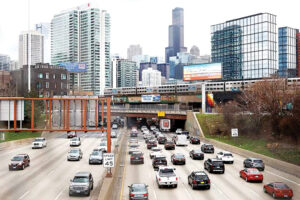
U.S. Transportation Secretary Pete Buttigieg has launched a $1 billion first-of-its-kind pilot program aimed at helping reconnect cities and neighborhoods racially segregated or divided by road projects, pledging wide-ranging help to dozens of communities despite the program’s limited dollars.
Under the Reconnecting Communities program, cities and states can now apply for the federal aid over five years to rectify harm caused by roadways that were built primarily through lower-income, Black communities after the creation of the interstate highway system in the 1950s.
New projects could include rapid bus transit lines to link disadvantaged neighborhoods to jobs; caps built on top of highways featuring green spaces, bike lanes and pedestrian walkways to allow for safe crossings over the roadways; repurposing former rail lines; and partial removal of highways.
Still, the grants, being made available under President Joe Biden’s bipartisan infrastructure law, are considerably less than the $20 billion the Democratic president originally envisioned.
Advocacy groups say the money isn’t nearly enough to have a major impact on capital construction for more than 50 citizen-led efforts nationwide aimed at dismantling or redesigning highways — from Portland, Oregon, to New Orleans; St. Paul, Minnesota; Houston; Tampa, Florida; and Syracuse, New York.
Meanwhile, some Republicans, including possible 2024 presidential contender Florida Gov. Ron DeSantis, have derided the effort as the “woke-ification” of federal policy, suggesting political crosswinds ahead in an election season.
Flanked by Black leaders at the site of a soon-to-start rapid bus line in Birmingham, Alabama, Buttigieg highlighted the potential of federal infrastructure money to boost communities. Close to half of Birmingham’s population lives within a half a mile of planned stations along the new 15-mile bus corridor. City leaders say the line will open up access around Interstate 65 — which cuts through the city’s Black neighborhoods — providing connections to jobs in the corridor as well as to the University of Alabama at Birmingham and other schools.
“Transportation can connect us to jobs, services, and loved ones, but we’ve also seen countless cases around the country where a piece of infrastructure cuts off a neighborhood or a community because of how it was built,” Buttigieg said.
“We can’t ignore the basic truth: that some of the planners and politicians behind those projects built them directly through the heart of vibrant populated communities,” he said. “Sometimes as an effort to reinforce segregation. Sometimes because the people there have less power to resist. And sometimes as part of a direct effort to replace or eliminate Black neighborhoods.”
He described Reconnecting Communities as a broad “principle” of his department — not just a single program — to help remake infrastructure, with many efforts underway.
The U.S. Department of Transportation has aimed to help communities that feel harmed by highway expansions, with the Federal Highway Administration last year taking a rare step to pause a proposed $9 billion widening project in Houston, partly over civil rights concerns. That move likely spurred action in other places such as Austin, Texas, where environmental and racial justice groups recently filed a lawsuit to force the Texas transportation agency to better lay out the impacts of a proposed highway expansion there.
Buttigieg, a former mayor of South Bend, Indiana, who unsuccessfully ran for president in 2020, drew fire from some Republicans earlier this year when he said the federal government had an obligation to address the harms of racist design in highways.
“There’s trees they’re putting in, they’re saying that highways are racially discriminatory. I don’t know how a road can be that,” DeSantis said in February.
In his remarks during the announcement of the plan, Buttigieg pushed back at critics, noting that “there is nothing sacred about the status quo” with roads and bridges.
“They are not divinely ordained; they are decisions,” Buttigieg said. “And we can make better decisions than what came before.”
Under the program, $195 million in competitive grants will be awarded this year, of which $50 million will be devoted for communities to conduct planning studies.
The Truckload Authority News Staff, comprised of award winning journalists and graphic artists, produces content for Truckload Authority, working in cooperation with the Truckload Carriers Association staff. Truckload Authority aims to keep TCA members abreast on the latest trends in the trucking industry as well as articles that feature TCA member executives and drivers. The Truckload Authority staff is based in Little Rock, Arkansas.








